Thư viện tài liệu, ebook tổng hợp lớn nhất Việt Nam
Website chia sẻ tài liệu, ebook tham khảo cho các bạn học sinh, sinh viên

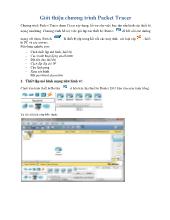 Giới thiệu chương trình Packet Trecer
Giới thiệu chương trình Packet TrecerGiới thiệu Chương trình Packet Tracer được Cisco xây dựng, hỗ trợ cho việc học tập cấu hình các thiết bị mạng của hãng. Chương trình hỗ trợ việc giả lập các thiết bị: Router để kết nối các đường mạng với nhau, Switch là thiết bị tập trung kết nối các máy tính, các loại cáp , thiết bị PC và các servers. Nội dung nghiên cứu: - Cách thiết lập mô h...
 14 trang | Chia sẻ: tlsuongmuoi | Ngày: 27/05/2013 | Lượt xem: 2282 | Lượt tải: 2
14 trang | Chia sẻ: tlsuongmuoi | Ngày: 27/05/2013 | Lượt xem: 2282 | Lượt tải: 2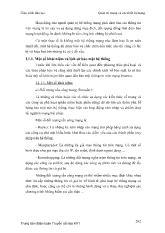 Một số khái niệm và lịch sử bảo mật hệ thống
Một số khái niệm và lịch sử bảo mật hệ thốngTrước khi tìm hiểu các vấn đề liên quan đến phương thức phá hoại và các biện pháp bảo vệ cũng như thiết lập các chính sách về bảo mật, ta sẽ tìm hiểu một số khái niệm liên quan đến bảo mật thông tin trên mạng Internet. I.1.1.1. Một số khái niệm: a) Đối tượng tấn công mạng (Intruder): Là những cá nhân hoặc các tổ chức sử dụng các kiến thức về mạng ...
 57 trang | Chia sẻ: tlsuongmuoi | Ngày: 27/05/2013 | Lượt xem: 2050 | Lượt tải: 0
57 trang | Chia sẻ: tlsuongmuoi | Ngày: 27/05/2013 | Lượt xem: 2050 | Lượt tải: 0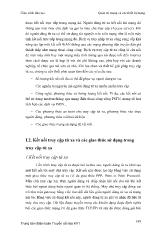 Kết nối truy cập từ xa và các giao thức sử dụng trong truy cập từ xa
Kết nối truy cập từ xa và các giao thức sử dụng trong truy cập từ xa1.Kết nối truy cập từ xa Tiến trình truy cập từ xa được mô tả như sau: người dùng từ xa khởi tạo một kết nối tới máy chủ truy cập. Kết nối này được tạo lập bằng việc sử dụng một giao thức truy cập từ xa (ví dụ giao thức PPP- Point to Point Protocol). Máy chủ truy cập xác thực người dùng và chấp nhận kết nối cho tới khi kết thúc bởi người dùng hoặc...
 62 trang | Chia sẻ: tlsuongmuoi | Ngày: 27/05/2013 | Lượt xem: 3039 | Lượt tải: 0
62 trang | Chia sẻ: tlsuongmuoi | Ngày: 27/05/2013 | Lượt xem: 3039 | Lượt tải: 0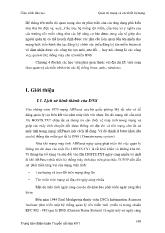 Lịch sử hình thành của DNS
Lịch sử hình thành của DNSVào những năm 1970 mạng ARPanet của bộ quốc phòng Mỹ rất nhỏ và dễ dàng quản lý các liên kết vài trăm máy tính với nhau. Do đó mạng chỉ cần một file HOSTS.TXT chứa tất cả thông tin cần thiết về máy tính trong mạng và giúp các máy tính chuyển đổi được thông tin địa chỉ và tên mạng cho tất cả máy tính trong mạng ARPanet một cách dễ dàng. Và đó chính ...
 36 trang | Chia sẻ: tlsuongmuoi | Ngày: 27/05/2013 | Lượt xem: 4278 | Lượt tải: 2
36 trang | Chia sẻ: tlsuongmuoi | Ngày: 27/05/2013 | Lượt xem: 4278 | Lượt tải: 2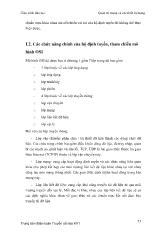 Các chức năng chính của bộ định tuyến, tham chiếu mô hình OSI
Các chức năng chính của bộ định tuyến, tham chiếu mô hình OSIMô hình OSI đã được học ở chương 1 gồm 7 lớp trong đó bao gồm - 3 lớp thuộc về các lớp ứng dụng o lớp ứng dụng o lớp trình bày o lớp phiên - 4 lớp thuộc về các lớp truyền thông o lớp vận chuyển o lớp mạng o lớp liên kết dữ liệu o lớp vật lý Đối với các lớp truyền thông: - Lớp vận chuyển: phân chia / tái thiết dữ liệu thành các dòng chảy dữ liệu. Cá...
 75 trang | Chia sẻ: tlsuongmuoi | Ngày: 27/05/2013 | Lượt xem: 2130 | Lượt tải: 0
75 trang | Chia sẻ: tlsuongmuoi | Ngày: 27/05/2013 | Lượt xem: 2130 | Lượt tải: 0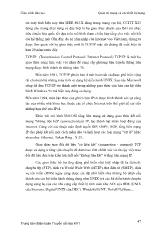 Chức năng chính của - Giao thức liên mạng IP(v4)
Chức năng chính của - Giao thức liên mạng IP(v4)Trong phần này trình bày về giao thức IPv4 (để cho thuận tiện ta viết IP có nghĩa là đề cập đến IPv4). Mục đích chính của IP là cung cấp khả năng kết nối các mạng con thành liên mạng để truyền dữ liệu. IP cung cấp các chức năng chính sau: - Định nghĩa cấu trúc các gói dữ liệu là đơn vị cơ sở cho việc truyền dữ liệu trên Internet. - Định nghĩa phươ...
 26 trang | Chia sẻ: tlsuongmuoi | Ngày: 27/05/2013 | Lượt xem: 2650 | Lượt tải: 3
26 trang | Chia sẻ: tlsuongmuoi | Ngày: 27/05/2013 | Lượt xem: 2650 | Lượt tải: 3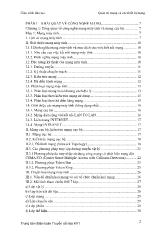 Giáo trình Quản trị mạng và các thiết bị mạng
Giáo trình Quản trị mạng và các thiết bị mạngPHẦN I KHÁI QUÁT VỀ CÔNG NGHỆ MẠNG . 7 Chương 1: Tổng quan về công nghệ mạng máy tính và mạng cục bộ 7 Mục 1: Mạng máy tính 7 I. Lịch sử mạng máy tính 7 II. Giới thiệu mạng máy tính . 10 I.1. I.Định nghĩa mạng máy tính và mục đích của việc kết nối mạng 10 I.1.1. Nhu cầu của việc kết nối mạng máy tính . 10 I.1.2. Định nghĩa mạng máy tính 10 I.2. Đặc...
 45 trang | Chia sẻ: tlsuongmuoi | Ngày: 27/05/2013 | Lượt xem: 2151 | Lượt tải: 1
45 trang | Chia sẻ: tlsuongmuoi | Ngày: 27/05/2013 | Lượt xem: 2151 | Lượt tải: 1 Xây dựng một Intranet đơn giản
Xây dựng một Intranet đơn giảnMạng sở hữu riêng của một tổ chức, công ty Phạm vi giới hạn Khoảng vài km, Phục vụ từ 10 100 user Kênh truy cập chia sẻ (shared) 10100 Mbps Thiết bị twisted pair, coaxial cable, fibre optic, wireless Chủ yếu là chuẩn Ethernet
 30 trang | Chia sẻ: tlsuongmuoi | Ngày: 27/05/2013 | Lượt xem: 2273 | Lượt tải: 1
30 trang | Chia sẻ: tlsuongmuoi | Ngày: 27/05/2013 | Lượt xem: 2273 | Lượt tải: 1 Ip address classes
Ip address classesTổng quát: IP address classes 1.0.0.0 - 126.0.0.0 : Class A. 127.0.0.0 : Loopback network. 128.0.0.0 - 191.255.0.0 : Class B. 192.0.0.0 - 223.255.255.0 : Class C. 224.0.0.0 < 240.0.0.0 : Class D, multicast. >= 240.0.0.0 : Class E, reserved. Network address Network address là địa chỉ xác định một mạng riêng biệt, là cơ sở để phân...
 30 trang | Chia sẻ: tlsuongmuoi | Ngày: 27/05/2013 | Lượt xem: 3275 | Lượt tải: 1
30 trang | Chia sẻ: tlsuongmuoi | Ngày: 27/05/2013 | Lượt xem: 3275 | Lượt tải: 1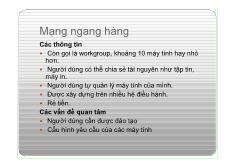 Mạng ngang hàng
Mạng ngang hàngCác thông tin Còn gọi là workgroup, khoảng 10 máy tính hay nhỏ hơn. Người dùng có thể chia sẻ tài nguyên như tập tin, máy in. Người dùng tự quản lý máy tính của mình. Được xây dựng trên nhiều hệ điều hành. Rẻ tiền. Các vấn đề quan tâm Người dùng cần được đào tạo Cấu hình yêu cầu của các máy tính
 30 trang | Chia sẻ: tlsuongmuoi | Ngày: 27/05/2013 | Lượt xem: 2273 | Lượt tải: 0
30 trang | Chia sẻ: tlsuongmuoi | Ngày: 27/05/2013 | Lượt xem: 2273 | Lượt tải: 0

